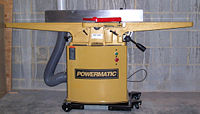
Jointer
Encyclopedia
- For the machine used to make joints using wooden biscuits or plates, see Biscuit joinerBiscuit joinerA biscuit joiner or sometimes plate joiner is a woodworking tool used to join two pieces of wood together. A biscuit joiner uses a small tungsten carbide tipped, circular saw blade to cut a crescent shaped hole in the opposite edges of two pieces of wood or wood composite panels...

Woodworking machine
A Woodworking machine is a machine that is intended to process wood. These machines are usually powered by electric motors and are used extensively in woodworking...
used to produce a flat surface along a board's length.
The jointer derives its name from its primary function of producing flat edges on boards prior to joining them edge-to-edge to produce wider boards. The use of this term probably arises from the name of a type of hand plane, the jointer plane
Jointer plane
The jointer plane is a type of hand plane used primarily to straighten the edges of boards in the operation known as jointing. A jointer plane may also be used to flatten the face of a board. Its long length is designed to 'ride over' the undulations of an uneven surface, skimming off the peaks,...
, which is also used primarily for this purpose.

Design
Fundamentally, a jointer consists of two parallel tables, a moveable fence which is normally set perpendicular to the tables, and a cutter head which is typically driven by an electric induction motorInduction motor
An induction or asynchronous motor is a type of AC motor where power is supplied to the rotor by means of electromagnetic induction. These motors are widely used in industrial drives, particularly polyphase induction motors, because they are robust and have no brushes...
. (Older machines were driven by belts from line shaft
Line shaft
A line shaft is a power transmission system used extensively during the Industrial Revolution. Prior to the widespread use of electric motors small enough to be connected directly to each piece of machinery, line shafting was used to distribute power from a large central power source to machinery...
s.)
The two tables are referred to as the infeed (table from which the work piece is fed into the machine) and outfeed (table to which the work piece is fed as it leaves the machine). The work piece to be planed flat is placed on the infeed table and passed over the cutter head to the outfeed table.
The cutter head contains two or more knives which are honed to a very sharp edge. The knives are arranged radially in the cylindrical cutter head such that their cutting edges protrude from the cutter head so that they will come into contact with the board being cut as the cutter head spins. The cutter head's axis of rotation is parallel to the table surfaces and perpendicular to the feed direction. The knives cut into the board in the direction opposite to the feed. Some, more expensive, jointer models contain a spiral, or helical, cutting head. This configuration has many individually mounted, self-indexing knives that can be rotated to a new edge when necessary.
The infeed and outfeed tables can be raised or lowered independently of each other and in relation to the cutter head although the outfeed table is normally set so that it is level with the knives when at the top dead centre of the rotation of the cutter head. The infeed table is adjusted so that it is lower than the outfeed table and this gives the depth of cut.
Jointers for home workshops usually have a 4-6 inch (100-150mm) width of cut. Larger machines, often 8-16 inches (200-400mm), are used in industrial settings.
Operation

A jointer may also be used to flatten the face of a board, in which case the sole focus is to produce a flat surface on the face of the board and the fence is not used. This procedure is often performed prior to edge jointing so that the board has a flat reference face for subsequent operations.

The timber is turned end for end and the same procedure is done to the section "B". This is repeated as required with the operator sighting along the length of the timber from time to time to check on straightness of the timber. When the timber is almost straight, the guard is replaced and the last cut is made in the normal way.
Twisted material is treated in a similar way. The operator lays the timber on the bed of the machine and rocks it slowly from side to side to estimate the amount of twist. If there is, say, 20mm of twist in the board, he holds the board level and takes 10mm off one end, then repeats it for the other end.
Jointers are also used for making rebates (also known as rabbets in North America) in finished timber. The fence is set to the width of the rebate and the infeed table is set to the depth. A jointer that is used for rebating has the outside ends of its blades also sharpened and set with a small clearance from the cutter head.
A jointer cannot be used to create a board of even thickness along its length. For this task, after jointing one face, a thickness planer is used.
Thickness planers and jointers are often combined into one machine, with the work piece passing underneath the same rotating blade for thicknessing, but in the opposite direction. In the UK this is called a planer–thicknesser or over–and–under.

